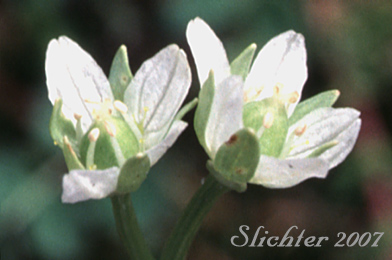
A close-up of the flowers of small grass-of-Parnassus photographed atop the ridge to the west of Wonder Lake, Denali National Park.........June 25, 2002.

A close-up of the flowers of small grass-of-Parnassus photographed atop the ridge to the west of Wonder Lake, Denali National Park.........June 25, 2002.
 Characteristics:
Characteristics:
Also known as Kotzebue's grass-of-Parnassus, small grass-of-Parnassus has one to several erect and simple stems from 1-20 cm high arising from a cluster of basal leaves atop a short rootstock. The flower stem typically has one sessile, small leaf on the lower third of the stem. The stems and leaves are all glabrous. The petioles of the basal leaves are 4-35 mm long while the ovate elliptic or ovate-triangular blades are 8-20 mm long and 6-20 mm wide. The base of the blade may taper gradually or abruptly to the petiole while its tip ranges from obtuse to acute.
The inflorescence consists of a single flower at the apex of the stem. Each of the 5 sepals is elliptic in shape with obtuse to acute tips, and 3-7 mm long and 1.4-2.2 mm wide. The petals are each slightly short to slightly longer than the sepals, elliptic to oblanceolate in shape, and measuring 3.5-6.5 mm long and 1.6-3 mm wide. The blades of the petals contain 1-3 veins (See photo above.). The petals wither and are persistent in fruit. The filaments of the fertile stamens are 2-3 mm long with the anthers measuring 0.5-1 mm long. The sterile stamens, known as staminoda, are 2-3 mm long, divided into 3-6 thin, globe-tipped lobes up to 1.4 mm long. The style is absent while the 4 stigmas are up to 1 mm long.
Small grass-of-Parnassus grows on moist slopes, wet cliffs, and in moist tundra up to 3200 meters in elevation. It is found at lower elevations in the northern extent of its range, and in subalpine to alpine habitats in the mountains in the southern extent of its range.
Also found over much of Siberia, small grass-of-Parnassus may be found from Alaska east across the Arctic to Baffin Island, Greenland and Labrador, and southward in the mountains to southern British Columbia, southwestern Alberta, western Montana, Idaho, northern and western Wyoming, north-central Colorado, and in the the Ruby Mts. of northeastern Nevada. In our range, it is found in north-central Washington in the mountains of Okanogan County.